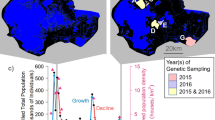Abstract
Corridors are a popular tool for conservation of small populations. However, two purported benefits of corridors, increasing gene flow and providing a means for the recolonization of extinct patches of habitat (population rescue), may have unappreciated impacts on the likelihood that a new allele will become incorporated (fixed) within a population. Using a simulation model, I demonstrate that connecting a stable, isolated population with a population that requires periodic rescue (due to extinction via natural or anthropogenic disturbance) can affect fixation of alleles in the stable population, largely by changing the effective population size Ne of the two-patch complex. When disturbance is rare, connecting the two patches with corridors can increase fixation of beneficial alleles and increase loss of harmful alleles. However, the opposite occurs when rates of disturbance are high: corridors can promote fixation of harmful alleles and reduce fixation of beneficial alleles. Because the impact of corridors hinges upon disturbance frequency (i.e. rate of population rescue), population growth rate, movement rates, and habitat quality, different species are likely to have different responses to corridor-mediated fixation, even if the species reside within the same ecological community. By changing fixation, corridors could thus either promote adaptation or extinction.
Similar content being viewed by others
References
Baker RR (1978) The Evolutional Ecology of Animal Migration. Hodder and Stoughton, London
Blueweiss L, Fox H, Kudzma V, Nakashima D, Peters R, Sams S (1978) Relationships between body size and some life history parameters. Oecologia 37: 257–272
Bowne DR, Bowers MA (2004) Interpatch movements in spatially structured populations: a review. Land. Ecol. 19: 1–20
Dobzhansky T (1970) Genetics of the Evolutionary Process. Columbia University Press, New York
Frankham R (1995) Conservation genetics. Ann. Rev. Genetics 29: 305–327
Haddad NM, Bowne DR, Cunningham A, Danielson BJ, Levey DJ, Sargent S, Spira T (2003) Corridor use by diverse taxa. Ecology 84: 609–615
Haldane JBS (1927) A mathematical theory of natural and artificial selection. V. Selection and mutation. Proc. Cambridge Phil. Soc. 23: 838–844
Kimura M (1962) On the probability of fixation of mutant genes in a population. Genetics 47: 713–719
Lynch M, Conery J, Bürger R. (1995) Mutation accumulation and the extinction of small populations. Am. Nat. 146: 489–518
Maruyama T (1970) On the fixation probability of mutant genes in a subdivided population. Genet. Res. 15: 221–225
Mech SG, Hallett JG (2001) Evaluating the effectiveness of corridors: a genetic approach. Cons. Biol. 15: 467–474
Otto SP, Whitlock MC (1997) The probability of fixation in populations of changing size. Genetics 146: 723–733
Pickett STA, White PS (1985) The Ecology of Natural Disturbance and Patch Dynamics. Academic Press, New York
Rosenberg DK, Noon BR, Meslow EC (1997) Biological corridors: form, function, and efficacy. Bioscience 47: 677–687
Skellam JG (1951) Random dispersal in theoretical populations. Biometrika 38:196–216
Tewksbury JJ, Levey DJ, Haddad NM, Sargent S, Orrock JL, Weldon A, Danielson BJ, Brinkerhoff J, Damschen EI, Townsend P (2002) Corridors affect plants, animals, and their interactions in fragmented landscapes. Proc. Natl. Acad. Sci. U.S.A. 99: 12923–12926
Whitlock MC (2003) Fixation probability and time in subdivided populations. Genetics 164: 767–779
Whitlock MC, Barton NH (1997) The effective size of a metapopulation. Genetics 146: 427–441
Acknowledgements
B. Danielson, M. Whitlock, F. Janzen, J. Nason, T. Kawecki, D. Coltman, E. Damschen, D. Adams, R. Dyer, N. Haddad, and the ELVIS labgroup at Iowa State University provided insightful discussion and comments on previous drafts of the manuscript. Financial support provided by the Ecology and Evolutionary Interdepartmental Graduate Program at ISU, the National Science Foundation, and a Science to Achieve Results Fellowship from the U.S. Environmental Protection Agency. Portions of this work were conducted while a Postdoctoral Associate at the National Center for Ecological Analysis and Synthesis, a Center funded by NSF (Grant #DEB-0072909), the University of California, and the Santa Barbara campus.
Author information
Authors and Affiliations
Corresponding author
Rights and permissions
About this article
Cite this article
Orrock, J.L. Conservation corridors affect the fixation of novel alleles. Conserv Genet 6, 623–630 (2005). https://doi.org/10.1007/s10592-005-9016-6
Received:
Accepted:
Published:
Issue Date:
DOI: https://doi.org/10.1007/s10592-005-9016-6




